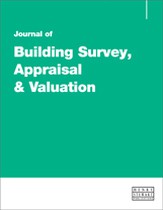The effectiveness of implementing unmanned aerial vehicles to survey buildings
Abstract
Unmanned aerial vehicles (UAVs) are becoming an increasingly viable tool in conducting building surveys. They are becoming available off the shelf. However, the legislation litigating their use is failing to keep up with the technological developments. This paper focuses on how effective the technology is at identifying building defects in hard-to-reach locations, specifically, in contrast to traditional methods such as MEWPs and scaffolding. Previous reviews have been examined, analysing their reliability and credibility. An in-depth examination of the current legislation prohibiting the use of UAVs has been evaluated, considering their current and future implications for the surveyor. UAVs are certainly an effective tool for conducting surveys. However, this is not true for all cases. Existing legislation prevents the ‘aerial work’ being undertaken in cities and built-up areas. The paper argues that the Civil Aviation Authority must become more lenient to commercial operations in these areas if the industry is to grow.
The full article is available to subscribers to the journal.
Author's Biography
Jordan Clarke is originally from Leicester and holds a BSc First Class Honours in Building Surveying from Salford University. Following his second year of studies, he undertook an industrial work placement in Manchester with the BWA Consultancy. During his time at Salford he was the Student Liaison Representative and Careers Ambassador for Building Surveying and received the Christopher Thompson Memorial Prize. After graduating, he joined Vantage Building Consultancy in their Manchester office and is currently working towards his RICS APC. He has experience in dilapidations, contract administration, reinstatement cost assessments and technical due diligence surveys.
Citation
Clarke, Jordan (2017, September 1). The effectiveness of implementing unmanned aerial vehicles to survey buildings. In the Journal of Building Survey, Appraisal & Valuation, Volume 6, Issue 2. https://doi.org/10.69554/WCTY1028.Publications LLP
